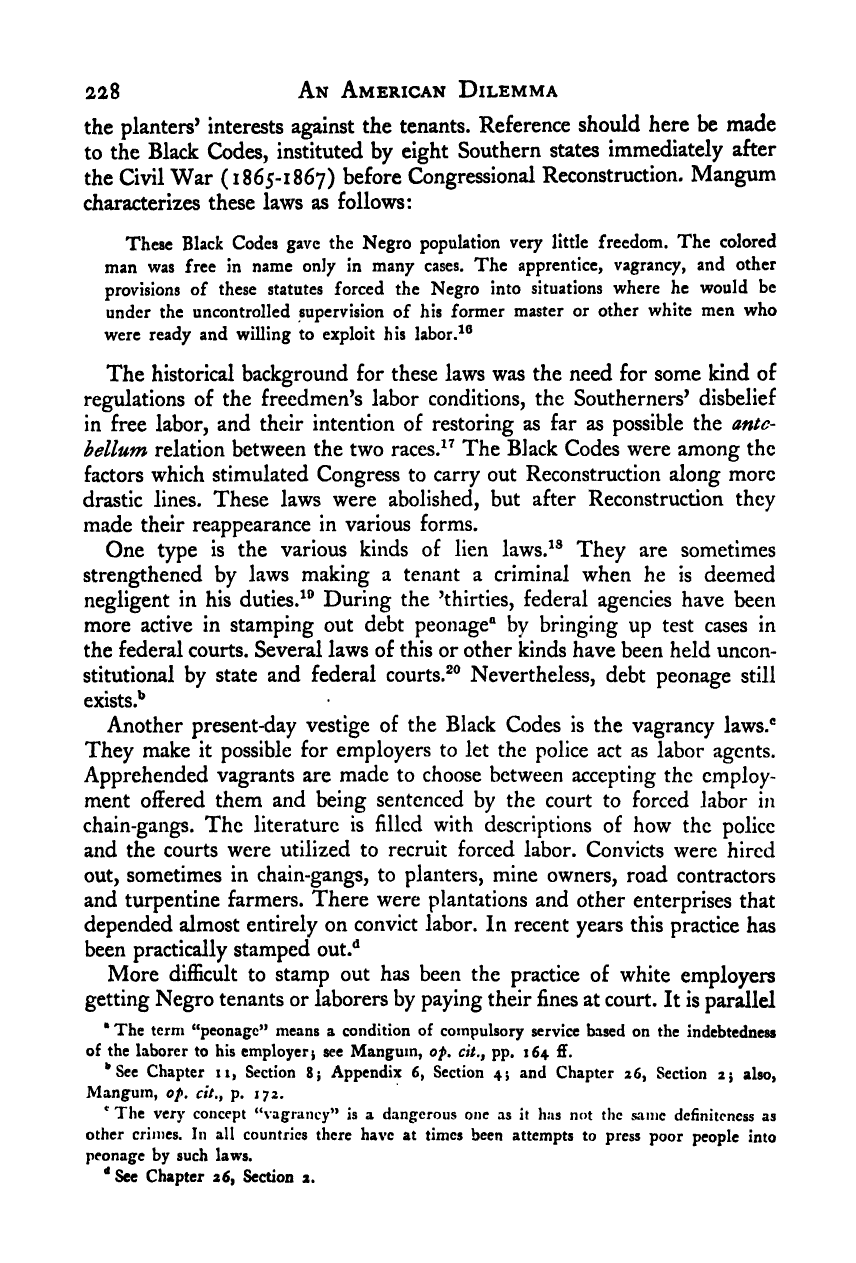Note: Gunnar Myrdal died in 1987, less than 70 years ago. Therefore, this work is protected by copyright, restricting your legal rights to reproduce it. However, you are welcome to view it on screen, as you do now. Read more about copyright.
Full resolution (TIFF) - On this page / på denna sida - IV. Economics - 10. The Tradition of Slavery - 4. The Tenancy Problem

<< prev. page << föreg. sida << >> nästa sida >> next page >>
Below is the raw OCR text
from the above scanned image.
Do you see an error? Proofread the page now!
Här nedan syns maskintolkade texten från faksimilbilden ovan.
Ser du något fel? Korrekturläs sidan nu!
This page has never been proofread. / Denna sida har aldrig korrekturlästs.
228 An American Dilemma
the planters^ interests against the tenants. Reference should here be made
to the Black Codes, instituted by eight Southern states immediately after
the Civil War (1865-1867) before Congressional Reconstruction. Mangum
characterizes these laws as follows:
These Black Codes gave the Negro population very little freedom. The colored
man was free in name only in many cases. The apprentice, vagrancy, and other
provisions of these statutes forced the Negro into situations where he would be
under the uncontrolled supervision of his former master or other white men who
were ready and willing to exploit his labor.^®
The historical background for these laws was the need for some kind of
regulations of the freedmen’s labor conditions, the Southerners^ disbelief
in free labor, and their intention of restoring as far as possible the ante-
bellum relation between the two races.^^ The Black Codes were among the
factors which stimulated Congress to carry out Reconstruction along more
drastic lines. These laws were abolished, but after Reconstruction they
made their reappearance in various forms.
One type is the various kinds of lien laws.^® They are sometimes
strengthened by laws making a tenant a criminal when he is deemed
negligent in his duties.^® During the ’thirties, federal agencies have been
more active in stamping out debt peonage® by bringing up test cases in
the federal courts. Several laws of this or other kinds have been held uncon-
stitutional by state and federal courts.^® Nevertheless, debt peonage still
exists.^*
Another present-day vestige of the Black Codes is the vagrancy laws.®
They make it possible for employers to let the police act as labor agents.
Apprehended vagrants are made to choose between accepting the employ-
ment offered them and being sentenced by the court to forced labor in
chain-gangs. The literature is filled with descriptions of how the police
and the courts were utilized to recruit forced labor. Convicts were hired
out, sometimes in chain-gangs, to planters, mine owners, road contractors
and turpentine farmers. There were plantations and other enterprises that
depended almost entirely on convict labor. In recent years this practice has
been practically stamped out.**
More difficult to stamp out has been the practice of white employers
getting Negro tenants or laborers by paying their fines at court. It is parallel
* The term “peonage” means a condition of compulsory service based on the indebtedness
of the laborer to his employer j
see Mangum, of, cit., pp. 164 S.
See Chapter ii, Section 8j Appendix 6, Section 4i and Chapter 26, Section 2} also,
Mangum, of, p. 172.
‘
The very concept “vagrancy” is a dangerous one as it has not the s.amc definiteness as
other crimes. In all countries there have at times been attempts to press poor people into
peonage by such laws.
‘*Scc Chapter 26, Section a.
<< prev. page << föreg. sida << >> nästa sida >> next page >>